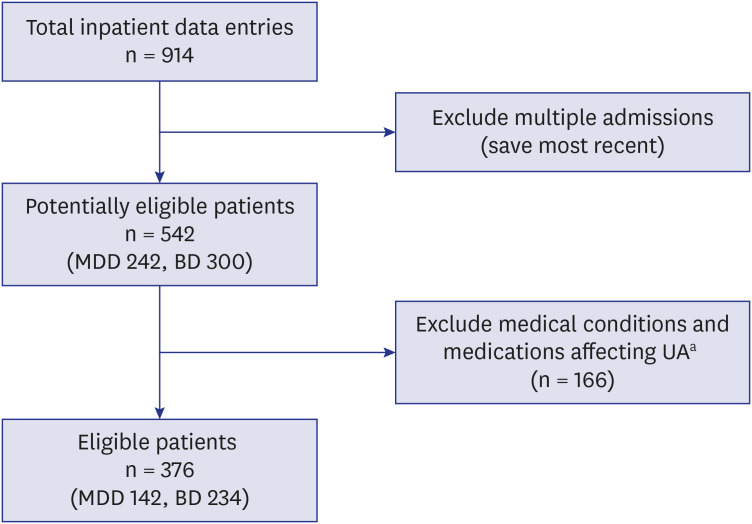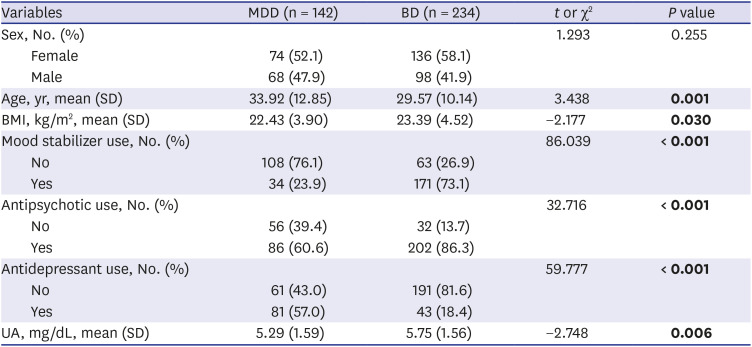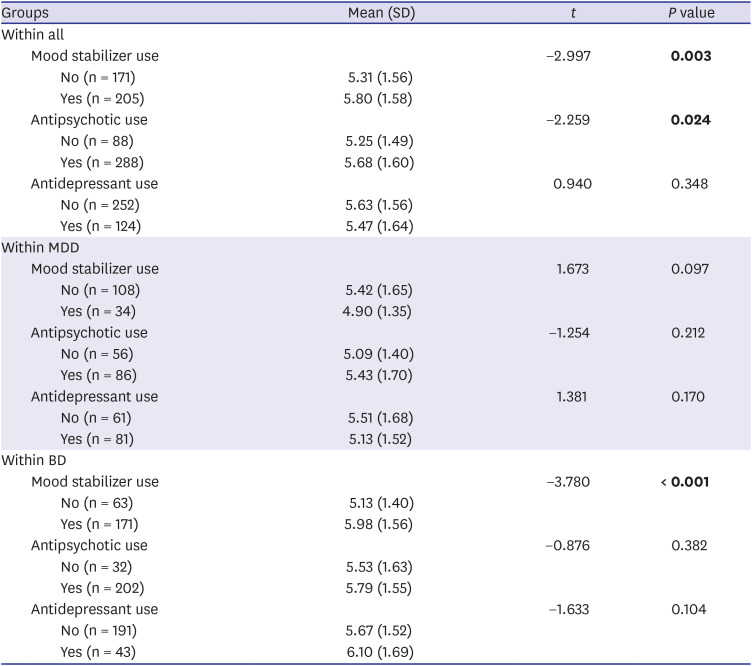1. Muzina DJ, Kemp DE, McIntyre RS. Differentiating bipolar disorders from major depressive disorders: treatment implications. Ann Clin Psychiatry. 2007; 19(4):305–312. PMID:
18058287.

2. Geddes JR, Miklowitz DJ. Treatment of bipolar disorder. Lancet. 2013; 381(9878):1672–1682. PMID:
23663953.

3. Song M, Yoon H, Choi I, Hong SD, Joung YS. Differences of clinical characteristics and phenotypes between prepubertal- and adolescent-onset bipolar disorders. J Korean Med Sci. 2010; 25(6):912–917. PMID:
20514314.

4. Joe S, Joo Y, Kim S. Experience of subjective symptoms in euthymic patients with bipolar disorder. J Korean Med Sci. 2008; 23(1):18–23. PMID:
18303193.

5. Sigitova E, Fišar Z, Hroudová J, Cikánková T, Raboch J. Biological hypotheses and biomarkers of bipolar disorder. Psychiatry Clin Neurosci. 2017; 71(2):77–103. PMID:
27800654.

6. Bartoli F, Carrà G, Clerici M. Purinergic dysfunction in bipolar disorder: any role for the antioxidant uric acid as a trait and state biomarker? Psychiatry Clin Neurosci. 2017; 71(6):417.

7. Malewska-Kasprzak MK, Permoda-Osip A, Rybakowski J. Disturbances of purinergic system in affective disorders and schizophrenia. Psychiatr Pol. 2019; 53(3):577–587. PMID:
31522198.

8. Ortiz R, Ulrich H, Zarate CA Jr, Machado-Vieira R. Purinergic system dysfunction in mood disorders: a key target for developing improved therapeutics. Prog Neuropsychopharmacol Biol Psychiatry. 2015; 57:117–131. PMID:
25445063.

9. Bartoli F, Crocamo C, Clerici M, Carrà G. Allopurinol as add-on treatment for mania symptoms in bipolar disorder: systematic review and meta-analysis of randomised controlled trials. Br J Psychiatry. 2017; 210(1):10–15. PMID:
27856422.

10. Jahangard L, Soroush S, Haghighi M, Ghaleiha A, Bajoghli H, Holsboer-Trachsler E, et al. In a double-blind, randomized and placebo-controlled trial, adjuvant allopurinol improved symptoms of mania in in-patients suffering from bipolar disorder. Eur Neuropsychopharmacol. 2014; 24(8):1210–1221. PMID:
24953766.

11. Machado-Vieira R, Soares JC, Lara DR, Luckenbaugh DA, Busnello JV, Marca G, et al. A double-blind, randomized, placebo-controlled 4-week study on the efficacy and safety of the purinergic agents allopurinol and dipyridamole adjunctive to lithium in acute bipolar mania. J Clin Psychiatry. 2008; 69(8):1237–1245. PMID:
18681754.

12. Bartoli F, Crocamo C, Mazza MG, Clerici M, Carrà G. Uric acid levels in subjects with bipolar disorder: a comparative meta-analysis. J Psychiatr Res. 2016; 81:133–139. PMID:
27442964.

13. Dos Santos Oliveira PM, Santos V, Coroa M, Ribeiro J, Madeira N. Serum uric acid as a predictor of bipolarity in individuals with a major depressive episode. Bipolar Disord. 2019; 21(3):235–243. PMID:
30375143.

14. Tatay-Manteiga A, Balanzá-Martínez V, Bristot G, Tabarés-Seisdedos R, Kapczinski F, Cauli O. Peripheral oxidative stress markers in patients with bipolar disorder during euthymia and in siblings. Endocr Metab Immune Disord Drug Targets. 2020; 20(1):77–86. PMID:
30848220.

15. Kim HS. Serum uric acid and metabolic syndrome: a retrospective cohort Study. J Korean Med Sci. 2019; 34(48):e324. PMID:
31833268.

16. Jeong J, Suh YJ. Association between serum uric acid and metabolic syndrome in Koreans. J Korean Med Sci. 2019; 34(48):e307. PMID:
31833264.

17. Albert U, De Cori D, Aguglia A, Barbaro F, Bogetto F, Maina G. Increased uric acid levels in bipolar disorder subjects during different phases of illness. J Affect Disord. 2015; 173:170–175. PMID:
25462413.

18. Wen S, Cheng M, Wang H, Yue J, Wang H, Li G, et al. Serum uric acid levels and the clinical characteristics of depression. Clin Biochem. 2012; 45(1-2):49–53. PMID:
22040815.

19. Bartoli F, Crocamo C, Bava M, Castagna G, Di Brita C, Riboldi I, et al. Testing the association of serum uric acid levels with behavioral and clinical characteristics in subjects with major affective disorders: a cross-sectional study. Psychiatry Res. 2018; 269:118–123. PMID:
30145291.

20. Wiener C, Rassier GT, Kaster MP, Jansen K, Pinheiro RT, Klamt F, et al. Gender-based differences in oxidative stress parameters do not underlie the differences in mood disorders susceptibility between sexes. Eur Psychiatry. 2014; 29(1):58–63. PMID:
23850061.

21. Muti M, Del Grande C, Musetti L, Marazziti D, Turri M, Cirronis M, et al. Serum uric acid levels and different phases of illness in bipolar I patients treated with lithium. Psychiatry Res. 2015; 225(3):604–608. PMID:
25547850.

22. Machado-Vieira R, Lara DR, Souza DO, Kapczinski F. Purinergic dysfunction in mania: an integrative model. Med Hypotheses. 2002; 58(4):297–304. PMID:
12027524.

23. Brown ES, Rush AJ, McEwen BS. Hippocampal remodeling and damage by corticosteroids: implications for mood disorders. Neuropsychopharmacology. 1999; 21(4):474–484. PMID:
10481830.

24. Stehle JH, Rivkees SA, Lee JJ, Weaver DR, Deeds JD, Reppert SM. Molecular cloning and expression of the cDNA for a novel A2-adenosine receptor subtype. Mol Endocrinol. 1992; 6(3):384–393. PMID:
1584214.

25. Brooks SC, Linn JJ, Disney N. Serotonin, folic acid, and uric acid metabolism in the diagnosis of neuropsychiatric disorders. Biol Psychiatry. 1978; 13(6):671–684. PMID:
737255.
26. Chung KH, Huang CC, Lin HC. Increased risk of gout among patients with bipolar disorder: a nationwide population-based study. Psychiatry Res. 2010; 180(2-3):147–150. PMID:
20483460.

27. Burnstock G. Purinergic signalling and disorders of the central nervous system. Nat Rev Drug Discov. 2008; 7(7):575–590. PMID:
18591979.

28. Lucae S, Salyakina D, Barden N, Harvey M, Gagné B, Labbé M, et al. P2RX7, a gene coding for a purinergic ligand-gated ion channel, is associated with major depressive disorder. Hum Mol Genet. 2006; 15(16):2438–2445. PMID:
16822851.

29. Barden N, Harvey M, Gagné B, Shink E, Tremblay M, Raymond C, et al. Analysis of single nucleotide polymorphisms in genes in the chromosome 12Q24.31 region points to P2RX7 as a susceptibility gene to bipolar affective disorder. Am J Med Genet B Neuropsychiatr Genet. 2006; 141B(4):374–382. PMID:
16673375.

30. Anumonye A, Reading HW, Knight F, Ashcroft GW. Uric-acid metabolism in manic-depressive illness and during lithium therapy. Lancet. 1968; 1(7555):1290–1293. PMID:
4172145.

31. Ring HA, Heller AJ, Marshall WJ, Johnson AL, Reynolds EH. Plasma uric acid in patients receiving anticonvulsant monotherapy. Epilepsy Res. 1991; 8(3):241–244. PMID:
1868823.

32. Yao JK, Reddy R, van Kammen DP. Reduced level of plasma antioxidant uric acid in schizophrenia. Psychiatry Res. 1998; 80(1):29–39. PMID:
9727961.

33. Vanwong N, Srisawasdi P, Ngamsamut N, Nuntamool N, Puangpetch A, Chamkrachangpada B, et al. Hyperuricemia in children and adolescents with autism spectrum disorder treated with risperidone: the risk factors for metabolic adverse effects. Front Pharmacol. 2017; 7:527. PMID:
28105014.

34. Kesebir S, Tatlıdil Yaylacı E, Süner O, Gültekin BK. Uric acid levels may be a biological marker for the differentiation of unipolar and bipolar disorder: the role of affective temperament. J Affect Disord. 2014; 165:131–134. PMID:
24882190.








 PDF
PDF Citation
Citation Print
Print





 XML Download
XML Download